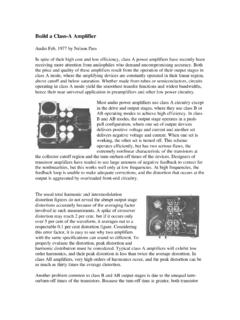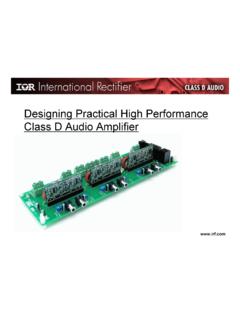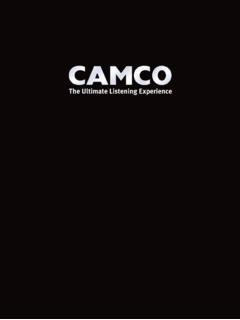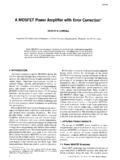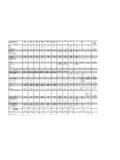Transcription of to the Published Amplifier Circuits - …
1 Page 1 Nelson Pass has over a half of a dozen patents covering audio inventions. He has also pub-lished a few dozen articles featuring power Amplifier Circuits , a couple in conjuction with oth-er authors. Most of these publications concern power Amplifier designs, but some are about preamplifier Circuits , phono preamp Circuits , crossovers, or even physical speaker construc-tion. Since all of the articles are available freely, there s really no reason not to read them all. They are each full of many useful tidbits of his experience, and sometimes introduce totally new concepts while at other times refining existing techniques to new levels.
2 But if you re itching to build your own power Amplifier , and want to know where to start, then it seems like some sort of guide would be helpful to point to the relevant articles. Even if you have read all of the articles, it helps to have an index of sorts to the various pieces of technology covered in each. This text hopes to provide such a first list will be individual topics of interest, followed by all of the articles that touch on the given topic. Note that a given design may not actually use the technology listed, but the cited article will at least discuss it in contrast to the specific implementation.
3 Sometimes it s a little difficult to say whether a given design is single-ended or push-pull, balanced or unbalanced, with or without feedback - at least when the article mentions modifications to achieve either. Abbreviations for the articles will be used which hopefully correspond to the DIY audio community standard abbreviations where possible. Afterward, a chronological list of articles is provided for a historical the sake of consistency, phono and speaker articles are excluded, as are articles that appear on the Pass Laboratories site from other authors. Although not technically considered ampli-fiers, the preamplifier Circuits are included simply because it might make sense to build some of the preamp Circuits as the input gain stage of an Amplifier .
4 Some of the First Watt schematics may be missing from the list, particularly the ones that do not offer balanced , 2011A Concise Guideto the Published Amplifier Circuitsof Nelson Pass Brian Willoughby, Sound Consultingpage 2 Technology Index:Balanced Input:A75, BOZ, SOZ, BOSOZ, SUSY, DOA, ZV1, ZV3, ZV4, XA, F1, ZV6, ZV7, PLH, BA1, BA2 Today s high-end DAC outputs are balanced, and generally demand a balanced-input Amplifier for optimum Sources:CAA, A40, A75, ZEN, ROZ, BOSOZ, DOA, POW, ZV2, XA, F1, ZV7, F2, PLH, ZV9, B1B, BA1, BA2 Class A amplifiers can be biased in one of three ways: resistors, constant current sources, or bias voltage source.
5 Current sources are more efficient than high power bias resistors, but less efficient than a bias voltage source. Zen Variation 2 focuses on the many current source Bias Supply (Aleph):ZV2, XA, ZV4, Patent #5,710,522 covers the Aleph current source. Zen Variations 2, 4 & 9 discuss the Symmetry Output Stage:SUSY, XA, F1?, ZV6, ZV7 (FIG 8) Patent #5,376,899 covers a balanced output stage power Amplifier with feedback to cancel distortion. Zen Variations 6 and 7 give example Circuits . I put the F1 on the list because it looks like it might be possible to convert it to Super Output Stage:CAS, ZEN, ROZ, BOZ, SEA, SOZ, BOSOZ, DOA, POW, ZV1, XA, F1, ZV6, ZV7, F2, ZV8, PLH, ZV9, LEAVE, B1B, DIST, BA1, SWEET, DLTS ingle-ended output stages perform similar to the atmosphere where we listen to music.
6 They are less efficient than push-pull stages, but require fewer parts (unless used as a balanced pair of sin-gle-ended stages, or in super symmetry). Biasing is possible with high power resistors or constant current sources. Distortion is primarily second Single-ended Output Stages:ZV1, ZV2, ZV4, XA, F1, ZV6, ZV7 Balanced single-ended output stages share characteristics of single-ended and push-pull output stages. They require up to twice the active components as a single-ended stage, and are the base for super symmetry. Distortion is primarily third / push-pull Output Stage:A40, CAS, C12, A75, ZV5, F5, PLH, LEAVE, DIST, BA2, SWEETThe most efficient Class A Amplifier design uses a pair of complementary transistors with a bias volt-age source.
7 Crossover distortion is a potential issue, as is the option to run the circuit in Class AB mode. Distortion is primarily third Output Stage:F1, F2 Nearly all amplifiers are voltage output Circuits employing feedback to control the wildly varying cur-rent as the complex speaker impedance reacts to this voltage. A current output Amplifier gives a speaker driver exactly what it needs to reproduce the waveform, so that the voltage can be ignored. See related articles on Current Source Amplifiers, Crossovers, and Full-Range Circuits :CAS, A75, SUSY, DOA, MOS, ZV8, ZV9, BA2, SWEETC ascode Circuits take some of the heat off of active transistors, but are less efficient.
8 Start with the first article in this list, which is dedicated to the topic. Other articles may only mention cascode as an optional 3 Bipolar (BJT) Power Transistors:CAA, A40, CAS, C12, A75, PLHFor those who are interested in BJT designs, a few of the early articles cover this technology. The MOSFET Citation 12 article is obviously focused on retrofitting MOSFET power transistors into an old design, but the context of the original BJT design might be interesting to see. Part 1 of the A75 articles also discusses a BJT design. The PLH article is the most recent to discuss an FET redesign of a BJT (MOSFET, JFET) Power Transistors:C12, A75, ZEN, ROZ, BOZ, SOZ, BOSOZ, DOA, ZV#, XA, MOS, F1, F2, F5, PLH, LEAVE, DIST, BA#, SWEET, DLTN early all of the Pass designs except the very oldest are based on FET power Input Stages or Output Stages:C12, DOA, F1J, F2J, F5, ZV8, ZV9, B1B, DIST, BA1, BA2, SWEET, DLTJFET inputs are perhaps more of a concern with preamplifiers, but they are worth considering any-where that high input impedance is Feedback (NFB).
9 CAA, A40, CAS, C12, A75, ZEN, ROZ, SUSY, DOA, POW, ZV1, ZV2, ZV4, XA, MOS, ZV5, F1, F5, ZV6, ZV7, ZV8, PLH, ZV9, DIST, BA1, BA2, SWEETT here is nothing wrong with negative feedback in a well-designed Amplifier . The worst issue with NFB is when it is used as a crutch to prop up poor or cheap designs. Note that many Nelson Pass designs incorporate some amount of feedback, and the patented super symmetry requires feedback in order to work. By the way, Positive Feedback causes Circuits to explode, so you probably won t see it in a power Supply:POW, XA, ZV9 Nearly every article has at least a basic power supply circuit .
10 Some articles have incremental im-provements or advanced techniques. The first on the list is an article from 2001 commenting on power supplies from a consumer Rail (unipolar) Power Supply:ZEN, ROZ, BOZ, ZV1, ZV4, F1, DLTS ingle-ended and Super Symmetry only need one supply Rail (bipolar) Power Supply:CAA, A40, C12, A75, SOZ, BOSOZ, ZV3, ZV5, F5, BA1, BA2 Complementary output stages basically require split power rails, but single-ended amplifiers can also use them (see BA1). ZV3 is dedicated to active supply :BOZ, BOSOZ, B1 BFair game for inclusion as the front end of any (non JFET?) Amplifier which needs help with input impedance.
